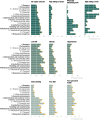Lifestyle-associated health risk indicators across a wide range of occupational groups: a cross-sectional analysis in 72,855 workers
- PMID: 33148214
- PMCID: PMC7641800
- DOI: 10.1186/s12889-020-09755-6
Lifestyle-associated health risk indicators across a wide range of occupational groups: a cross-sectional analysis in 72,855 workers
Abstract
Background: Identify and compare health risk indicators for common chronic diseases between different occupational groups.
Methods: A total of 72,855 participants (41% women) participating in an occupational health service screening in 2014-2019 were included. Occupation was defined by the Swedish Standard Classification of Occupation, and divided into nine major and additionally eight sub-major groups. These were analysed separately, as white- and blue-collar occupations and as low- and high-skilled occupations. Seven health risk indicators were self-reported: exercise, physical work situation, sitting at work and leisure, smoking, diet, and perceived health, whereas cardiorespiratory fitness, BMI and blood pressure were measured. These were further dichotomized (yes/no) and as clustering of risk indicators (≥3 vs. <3).
Results: The greatest variation in OR across sub-major and major occupational groups were seen for daily smoking (OR = 0.68 to OR = 5.12), physically demanding work (OR = 0.55 to OR = 45.74) and high sitting at work (OR = 0.04 to OR = 1.86). For clustering of health risk indicators, blue-collar workers had significantly higher clustering of health risks (OR: 1.80; 95% CI 1.71-1.90) compared to white-collar workers (reference). Compared to high-skilled white-collar workers, low-skilled white-collar workers had similar OR (2.00; 1.88-2.13) as high-skilled blue-collar workers (1.98; 1.86-2.12), with low-skilled blue-collar workers having the highest clustered risk (2.32; 2.17-2.48).
Conclusion: There were large differences in health risk indicators across occupational groups, mainly between high-skilled white-collar occupations and the other occupations, with important variations also between major and sub-major occupational groups. Future health interventions should target the occupational groups identified with the highest risk for effective disease prevention.
Keywords: Blue-collar; Cardiorespiratory fitness; Lifestyle; Low- and high-skilled occupations; Occupational groups; Occupations; Physical activity pattern; Risk indicators; White-collar.
Conflict of interest statement
Gunnar Andersson and Peter Wallin are employed at HPI Health Profile Institute.
Figures


Similar articles
-
Mediation of lifestyle-associated variables on the association between occupation and incident cardiovascular disease.Prev Med. 2023 Feb;167:107411. doi: 10.1016/j.ypmed.2022.107411. Epub 2022 Dec 30. Prev Med. 2023. PMID: 36592676
-
Associations between occupational indicators and total, work-based and leisure-time sitting: a cross-sectional study.BMC Public Health. 2013 Dec 1;13:1110. doi: 10.1186/1471-2458-13-1110. BMC Public Health. 2013. PMID: 24289321 Free PMC article.
-
Gender inequalities of psychosomatic complaints at work vary by occupational groups of white- and blue-collar and level of skill: A cross sectional study.PLoS One. 2024 Jul 11;19(7):e0303811. doi: 10.1371/journal.pone.0303811. eCollection 2024. PLoS One. 2024. PMID: 38990805 Free PMC article.
-
A review of occupational physical activity and sedentary behaviour correlates.Occup Med (Lond). 2016 Apr;66(3):185-92. doi: 10.1093/occmed/kqv164. Occup Med (Lond). 2016. PMID: 27016747 Review.
-
An integrative review: work environment factors associated with physical activity among white-collar workers.West J Nurs Res. 2014 Feb;36(2):262-83. doi: 10.1177/0193945913503417. Epub 2013 Sep 24. West J Nurs Res. 2014. PMID: 24065693 Review.
Cited by
-
Moderating effect of cardiorespiratory fitness on sickness absence in occupational groups with different physical workloads.Sci Rep. 2023 Dec 21;13(1):22904. doi: 10.1038/s41598-023-50154-9. Sci Rep. 2023. PMID: 38129646 Free PMC article.
-
Test@work: evaluation of workplace HIV testing for construction workers using the RE-AIM framework.BMC Public Health. 2021 Sep 24;21(1):1737. doi: 10.1186/s12889-021-11739-z. BMC Public Health. 2021. PMID: 34560853 Free PMC article.
-
Occupational status and health disparities among workers-An empirical study based on China health and nutrition survey data.PLoS One. 2025 May 23;20(5):e0324144. doi: 10.1371/journal.pone.0324144. eCollection 2025. PLoS One. 2025. PMID: 40408422 Free PMC article.
-
Structural and functional cardiac parameters across occupations: a cross-sectional study in differing work environments.Sci Rep. 2024 May 27;14(1):12115. doi: 10.1038/s41598-024-62190-0. Sci Rep. 2024. PMID: 38802474 Free PMC article.
-
Metabolic syndrome incidence in an aging workforce: Occupational differences and the role of health behaviors.SSM Popul Health. 2021 Jul 28;15:100881. doi: 10.1016/j.ssmph.2021.100881. eCollection 2021 Sep. SSM Popul Health. 2021. PMID: 34401460 Free PMC article.
References
-
- Tsutsumi A, Kayaba K, Tsutsumi K, Igarashi M. Association between job strain and prevalence of hypertension: a cross sectional analysis in a Japanese working population with a wide range of occupations: the Jichi medical school cohort study. Occup Environ Med. 2001;58(6):367–373. doi: 10.1136/oem.58.6.367. - DOI - PMC - PubMed
MeSH terms
Grants and funding
LinkOut - more resources
Full Text Sources
Medical

